For a company to grow, it needs many things, but primarily, it’s cash and people — and if you’re struggling to source both, it’s time to take a look at your talent acquisition strategy.
Investing in improving your acquisition strategy can help your organization attract and retain top talent, which leads to increased productivity, innovation, and revenue growth. Great, right? It can be, as long as you know where to start, what to do, and how to do it (you know, simple things).
For those starting from scratch (or even for those who just need some new ideas for their recruitment process), we’re going to show you what talent acquisition is, explore a few talent acquisition strategies, and teach you how to effectively implement these strategies in a company of any size.
TL;DR – Key Takeaways
Talent acquisition is the process of finding and recruiting new employees, and it consists of multiple steps, from workforce planning to making an offer and negotiation
In a typical HR team, a number of specialists handle talent acquisition, from the recruiter to the diversity and inclusion specialist
Talent acquisition and recruitment are vastly different, with talent acquisition being broader and focusing more on building relationships
There are eight steps in the talent acquisition process: aligning internally on the hiring priorities, fine-tuning job requirements, sourcing, shortlisting, making the hiring decision, onboarding, building a talent pool, and running employee performance reviews
One way to speed up talent acquisition is to make it faster and more data-driven with Toggl Hire skills tests!
What is talent acquisition?
Talent acquisition is the process of finding and recruiting new employees for an organization. It includes multiple steps, including workforce planning, sourcing, screening, and interviewing candidates, assessment testing, background and reference checks, and more.
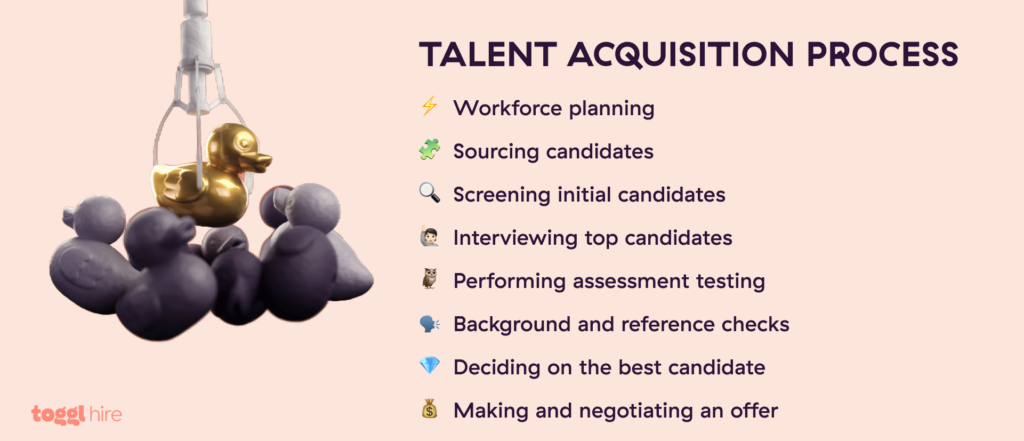
For example, let’s say you set out to hire a new sales development representative. You might:
Take a strategic approach to planning how the role fits into future HR goals and plans, including which skill requirements a qualified candidate should have and creating the job description for the role
Source great candidates from a variety of places (job boards, employee referrals, LinkedIn, etc.)
Screen the initial pool of applicants to filter out a handful of the best candidates
Interview several of the best applicants
Assess their hard and soft skills
Perform background and reference checks across their previous roles
Make a decision on the top SDR based on skills tests, previous employment history, interviews, salary expectations, and other hiring factors
Extend an offer to the top candidate
Who handles talent acquisition?
It depends on the size of your HR team and your talent acquisition needs. If you’re a solopreneur or have a single person doing all HR tasks, then the answer is, well, you or that one person.
If you have a dedicated HR team, here are some of the people to cover your talent acquisition strategies:
Recruiter: Does it all, from sourcing to making an offer
Talent Acquisition Specialist: Focuses on creating a talent acquisition strategy, from employer branding to recruitment marketing
Hiring Manager: Defines job requirements and selection criteria, works on the job description, oversees the interview process, and makes the hiring decision
HR Coordinator: Offers admin support by scheduling interviews, communicating with job seekers, and doing the backend work
HR Manager: Oversees the entire process and sets a global recruitment strategy, starting with future resource planning
HR Business Partner: Communicates with team leads and managers on the one hand and the HR team on the other to ensure skills gaps are filled, and the talent pipeline has the right kind of people
Diversity and Inclusion Specialist: Focuses on promoting DEI throughout the process and staying on top of talent acquisition trends in regard to DEI
What does a talent acquisition specialist do?
If you have a talent acquisition specialist in your HR department, they likely undertake various tasks daily, which include:
Sourcing candidates
Creating job postings
Building and maintaining talent pools
Assessing candidate skills
Managing the relationships with candidates and keeping them engaged
Collaborating with hiring managers throughout the entire recruitment process
Analyzing and reporting on data
How does this role and its job functions differ from that of a recruiter? A recruiter is an HR specialist who has a more narrow field of work.
Talent acquisition vs. recruitment: What’s the difference?
While it might seem like these terms are interchangeable at first, there are distinct differences between talent acquisition and recruiting.
Both deal with filling open positions, but what makes talent acquisition important is that it focuses more on attracting passive candidates, establishing a strong company culture, and carrying over those values to improve the employee experience after onboarding.
Talent acquisition has a broader scope and is usually ongoing. Recruitment focuses on a specific time frame for hiring a role and has a narrower scope.
| Talent Acquisition | Recruitment |
Establishes ongoing relationships with the best talent in the market | Communicates only with candidates who are actively looking for a job |
Engages in employer branding activities | Sometimes engages in employer brand activities (but usually not) |
Seeks to attract talent to the company for current and future roles | Only fills existing and immediate roles |
| Is devoted to improving the candidate experience | Candidate experience is an afterthought (they’re most interested in hiring promising candidates quickly) |
8 steps of the talent acquisition process
While the best talent acquisition practices presented below can help you improve an existing talent acquisition process, they will be of little use if you don’t have a process to work off of.
Whether you’re creating a talent acquisition process for the first time or are looking to revamp an existing one, use this talent acquisition strategy example as a base for planning for your new hire.
1. Align internally on hiring priorities
Before you contact candidates, consider the company’s hiring priorities and needs. We’re not talking only about your current situation — implement forward thinking and look into the future as well.
What are the most important traits for a candidate in this role?
How will this role develop in the upcoming years?
How does this role strategically fit into the organization’s direction?
What kind of skills gaps does this position fill?
Align hiring with these priorities at the beginning of the process so you don’t run into obstacles later on when it might be too late (or too costly) to make changes.
2. Fine-tune job requirements
Analyze what kind of tasks the new role should entail and what the main responsibilities are. Instead of copying standard job requirements from job boards, do your own analysis. Determine the following:
The tasks the candidate should perform on a daily basis
Their necessary qualifications
The previous experience they should have
Must-have vs. nice-to-have requirements
While fine-tuning the job requirements and description, remember to consider both hard and soft skills. It’s also worth defining what a great cultural fit might look like in the role.
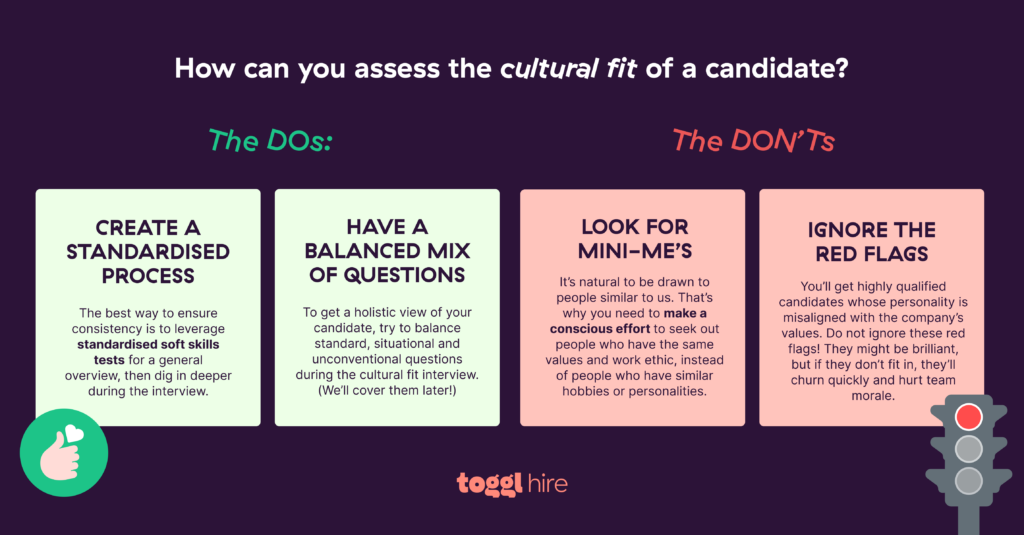
3. Start sourcing
At the sourcing stage, most talent acquisition professionals aim to find the best channels for filling the talent pipeline. This includes:
General job boards
Niche job boards
Professional platforms such as LinkedIn
Existing networks
Based on the role they’re hiring, talent acquisition specialists choose the channels most likely to provide the best person for the role. This is all part of reducing both time to fill and time to hire.
4. Shortlist top candidates
After sourcing an initial list of candidates, filter that list to focus on your top performers. Do this based on their:
Hard and soft skills
Previous work experience
Skills assessment test results
Interview skills
Overall impression of the candidate
You can do this manually, but using recruiting software and tools makes it much easier and faster. With Toggl Hire, for example, you can go from hundreds of candidates to a handful based on their skills test results.
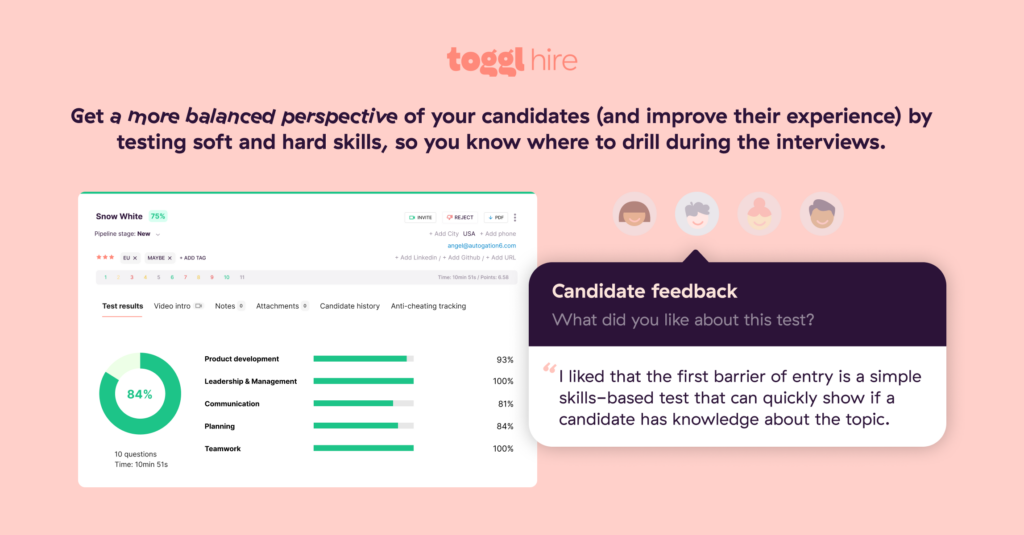
5. Make the hiring decision
With just a few of the best potential candidates left, it’s time to decide who gets the job offer. Aside from the previously mentioned criteria, keep in mind that you’re looking for a strategic addition to your team that makes sense in the months and years to come. So, think long-term impact and use quality of hire as your main hiring metric.
Quality of hire (sometimes written as QoH) is a hiring metric that reflects the value a new employee brings to an organization. It’s a comprehensive way to measure how successful a new hire will be in their role, and it encompasses both the pre-hire and post-hire experience.
6. Plan the onboarding process
Great new hire onboarding typically translates to higher employee retention and, naturally, lower employee turnover. So as soon as a new employee signs the job offer, start preparing for an effective onboarding process.
Based on the data collected on the candidate throughout the interview process, you should have enough to personalize and tailor the onboarding to each individual candidate. This way, they can hit the ground running from day one and ease into their role without any obstacles.
You make life easier for them (and you!) by introducing them to the company culture, their daily job duties, and their team as early as possible.
7. Continue building your talent pool
Just because you didn’t hire someone now, it doesn’t mean that they aren’t still high-quality candidates. Don’t scrap unsuccessful candidates. Instead, send them a compassionate rejection letter and keep them in your applicant tracking systems for your future staffing needs.
Here are some ways to continue building relationships with candidates:
Keep their contact information in your ATS or CRM
Build relationships by communicating with unsuccessful applicants and letting them know about new positions
Give them opportunities for learning and improvement, ideally for free, and ideally, those that align with your business objectives
Ask each job seeker who applied for feedback on your hiring processes and sourcing strategies, and apply this feedback to create a positive experience for future applicants
Over time, you’ll have an engaged pool of candidates without visiting job fairs or spending thousands on job ads.
8. Implement employee performance reviews
Talent acquisition takes more than just filling a role. Once someone is hired, check up on them through regular performance reviews to ensure they’re happy, and they feel like they’re making the desired impact. Use these insights and data pieces to refine your talent acquisition best practices for the future.
8 best practices for an effective talent acquisition strategy
Struggling with any one of the steps in the process mentioned above?
Perhaps you’re great at sourcing strong candidates but don’t feel like you’re able to get candidates excited about the roles you’re hiring for. Or, maybe you do well up until it’s time to make a hiring decision, and then senior executives can’t seem to agree on one candidate.
No matter if you already have a strong talent acquisition team or you’re just looking to build one, we can help. Here are eight best practices for creating a strong strategy for talent acquisition.
1. Build a strong employer brand
This refers to everything that makes you stand out as a potential employer. This includes your mission and vision, values, culture, opportunities for growth within the company, the types of people you hire, and more.
A unique employer brand attracts top talent and creates a competitive advantage in the talent acquisition landscape. According to FlexJobs, 95% of applicants state that the employer’s reputation impacts their decision whether to apply for a job or not.

Some of the things you could do include:
Building great About Us and Careers pages with relevant information about perks (including benefits, work-life balance, etc.)
Showcasing your mission, vision, and values on your website and social media channels
Being transparent about your hiring process and explaining the employee value proposition
Working on third-party profiles such as Glassdoor and making sure they accurately represent your employer brand
2. Embrace skills-based hiring
Move into the 21st century (like your competitors), and instead of creating friction in the application process with resumes and cover letters, use skills tests. Skills-based hiring helps both the candidates and the employer.
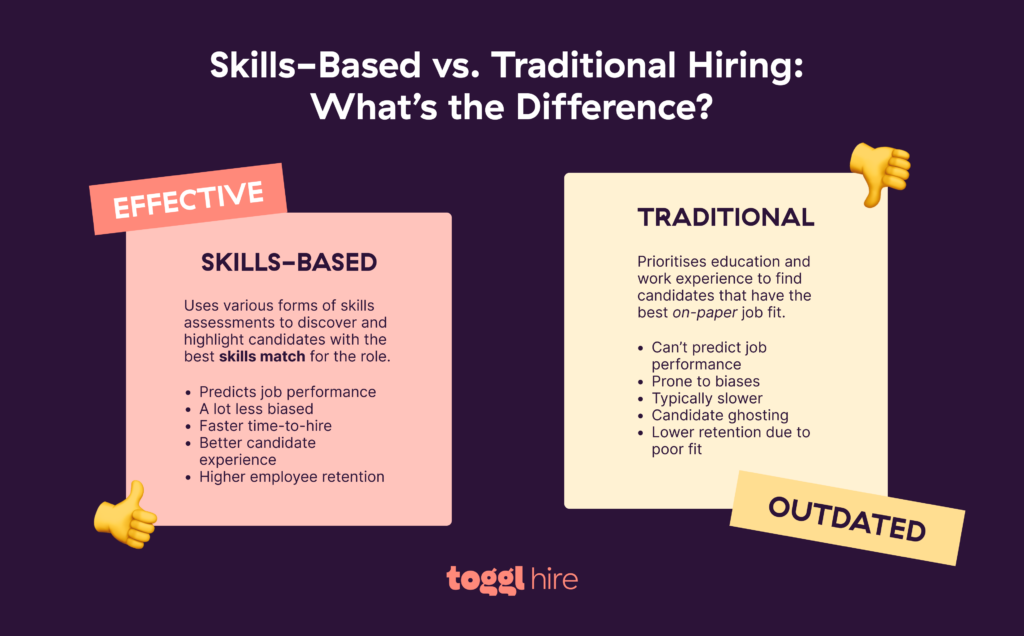
This gamifies the hiring process and makes it more exciting for the candidates compared to traditional job applications. More importantly, job seekers get feedback about their test performance immediately (at least with Toggl Hire).
Create a streamlined talent acquisition process and use Toggl’s skills-based hiring! Restricting job postings to candidates with a relevant four-year degree is an outdated concept that can greatly limit your team’s access to great talent.
3. Leverage AI and technology
AI and language learning models are breaking through in every aspect of our lives. In the realm of hiring, AI tools can help fill open positions more quickly by helping with candidate sourcing, job description writing, and more.
While there are some dangers with AI (privacy and data inaccuracy, among others), the technology can still be a great way to automate and optimize your talent acquisition process.
Some ways you can use AI (more specifically, ChatGPT) in talent acquisition include:
Creating personalized outreach and feedback messages for candidates at scale
Create customized job descriptions and job requirements (that promote diversity and inclusion)
Create and customize job ad copy
Write email templates for candidate outreach
Gather keywords for job descriptions
Take other employers’ job descriptions, simplify, edit, and personalize them
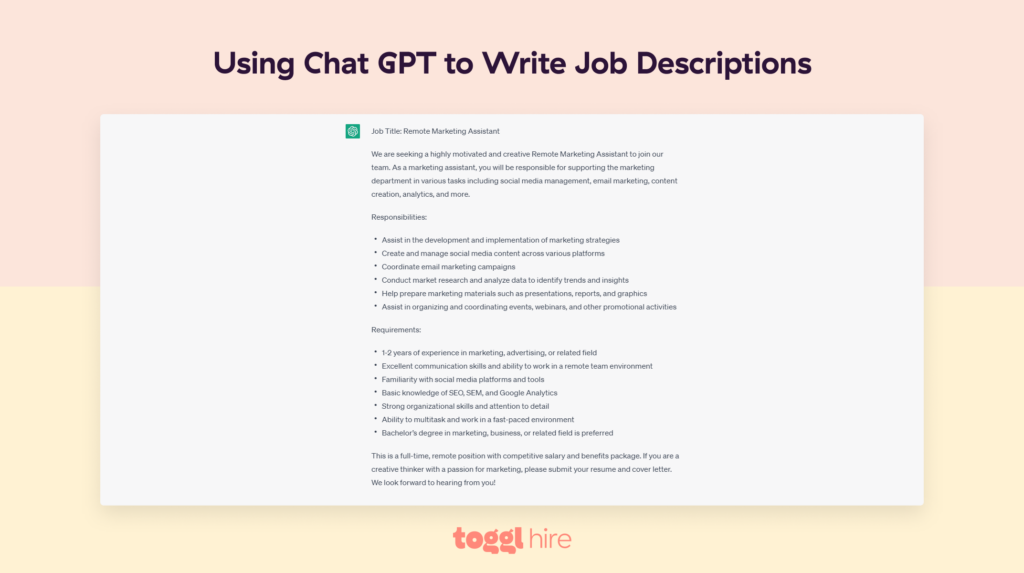
The sky is the limit with AI, and if you learn how to use it correctly (and ethically), it can be of massive help for automating tedious, repetitive tasks.
Explore artificial intelligence and tech solutions to streamline and enhance the talent acquisition process. AI-powered tools can assist in candidate screening, automate repetitive tasks, and provide data-driven insights for better decision-making.
4. Establish effective collaboration
The best way to capture top talent is to ensure your entire team is aligned. Recruiters, hiring managers, direct managers, and other stakeholders should be on the same page about the type of candidate you’re looking for.
Ensure all relevant stakeholders have information on:
The desired skill set and experience
The necessary soft skills the candidate should have
The stages of the hiring process
The interview process and questions
It can be useful for hiring managers to go through interview training. Once you have a good number of interviews behind you, ask your candidates what they think with an interview evaluation form to continue to improve the process.
5. Be strategic and think long-term
According to the Bureau of Labor Statistics, the median tenure of an employee is 4.1 years. This means that if you find someone amazing, they’re (likely) going to spend at least four years with you. It also means that your talent acquisition specialist needs to think long-term.
To achieve this, ask yourself the following questions:
What kind of skills gaps do we currently have?
What kind of hiring needs will we have in the future?
Will there be a skills shortage in this department in the future?
What kind of career advancement can we offer for this position?
How does this role fit into our 1-, 2- and 5-year hiring plans?
By answering these questions, you can accurately predict your future talent needs and create a solid talent pool of highly qualified candidates.
6. Implement data-driven decision-making
Say goodbye to the old days of hiring based on a gut feeling. Today’s HR professionals use data for every step of the hiring process. Before you even put together a job ad, leverage technology and collect different data to guide your future hiring decisions.
For example, you can collect various data points to find out:
Which hiring sources produce the best candidates (e.g. specialized job boards vs. sites like LinkedIn)
At which part of the recruiting funnel most candidates drop off
Whether your current application process creates a positive candidate experience
Which platforms drive the lowest cost of hire
A modern applicant tracking system, in combination with other HR tools, allows you to collect talent acquisition metrics that can guide your entire recruiting process.
7. Prioritize diversity and inclusion
Diverse and inclusive teams generally perform better, which means that practicing diversity and inclusion in recruitment is more than meeting a legal requirement.
McKinsey research shows that the most diverse teams are 35% more likely to have higher profits compared to more homogenous companies. They’re also more likely to be productive, test out new ideas, communicate and collaborate better, and in general, make a better team.

With tools such as Toggl Hire, you can make your recruiting process inclusive from the start. By starting off with a skills test, you’re focusing on the skills alone and putting all other traits aside. This way, you remove most unconscious bias and create an effective talent acquisition process.
8. Invest in employee training
If you want to acquire and retain talent, investing in them is a smart move. Employees who have training opportunities in the workplace are more likely to stay and grow within your company.
This means that initial investment in employee training can have a major return on investment on your overall business success. Moreover, you’ll decrease employee turnover by giving room for your talented employees to grow instead of hiring candidates all over again.
It’s also a smart idea to create a professional development plan for each individual candidate. It may take your human resources team some extra time, but it’s a superb way to make sure top talent stays.
Implement Best Practices in Talent Acquisition
The talent acquisition process is crucial for the growth of any company as this is a field of HR that does much of the heavy lifting with hiring. With a successful talent acquisition strategy, you can not only fill your current openings but also build a pipeline of qualified candidates for your future hiring needs.
And what better place to start than a skills test? With Toggl Hire, you can source, screen, and qualify candidates as soon as they apply. Within minutes, you find out if they have the right skills, and they learn if they’re a good fit for the job or not.
Wanna see how it works? Start now by browsing our skills test library.
Elizabeth is an experienced entrepreneur and content marketer. She has nine years of experience helping grow businesses and has experienced first-hand the impact of skills-based hiring in today's global, digital world.








